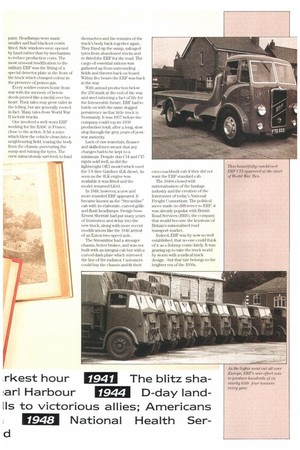• ERF built its 4 x 2 four-wheeler flagship right
Page 166

Page 167

If you've noticed an error in this article please click here to report it so we can fix it.
through to 1945 and the close of World War Two, but wartime shortages meant that the army's preferred Gardner 4LW diesels could not be supplied in sufficient numbers to satisfy the ERF production lines: 400 chassis a year had been planned at the outset of the war and 434 were built in 1939/40, before the rot set in.
Only 427 chassis were made in 1940/41 and 300 in 1941/2. This dwindled to 322 and 248 in the following two years with output down to 237 in 1944/5.
"We certainly did not make a lot of money out of the war," recalls Ernest. Sherratt. For the first time in the company's short history,. engines made tw other suppliers were fitted to keep things moving as wieldy as possible.
AEC 7.7-hire diesels, similar to those fitted hi the Matador gun tractors, were used. The military took the Gardner-p wvered trucks: civilian buyers got the substitute vehicles. Standard C14 units were used by the Royal Army Service Corps in the Normandy landings.
The C15 was powered by a livecylinder Gardner diesel, the 5LW. It had appeared several years before the start of the war to suit operators unhappy with the power (ff the four-cylinder engine.
While the civilian and military ERF trucks shared the same basic design there were a number of differences on the latter not, least to its radiator grille: the army eschewed chrome in favour of
paint. Headlamps were made smaller and had blackout cowls filled. Side windows were opened by hand rather than by mechanism to reduce production (INK The most unusual modification to the military ERF was the fitting of a special detector plate at the ft-4ml of the truck which changed colour in the presence of poison gas.
Every soldier comes home from war with the memory Id' heroic deeds pinned like a medal over his heart. Their tales may grow taller in the telling, but are generally rooted in fact. Many tales from World War 11 include trucks.
One involved a well-worn ERF working for the RASC in France, close to the action. It hit a mine which blew the vehicle clean into a neighbouring field, tearing the body from the chassis, puncturing the sump and mining the tyres. The crew miraculously survived, to haul
themselves and the remains of the truck's body back together again. They fixed up the sump, salvaged tyres from abandoned trucks anti re-fitted the ERF for the road. The cargo of essential rations was gathered up from surrounding fields and thrown back on board. Within five hours the ERF Was back in the war.
With annual product ion below: the 250 mark at the end of the war and steel rat toning a fact of life ft Fr the foreseeable future. ERF had tti battle on with the same dogged persistence as that little truck in Normandy. It was 1957 before the company could tc qi its 1939 production total, after a long, slow slog through the grey years of postwar austerity.
Lack of raw materials, finance and skilled men meant that any changes had to he kept to a minimum. Despite this CI4 and CI5 rights sold well, as did the lightweight 0E3 model which used the 3.8-litre Gardner 41.K diesel. As stain as the 41.K engine was available it was fined and the mot lel renamed LK49.
In 1948, however, a new and more rounded ERE' appeared. It became knowm as the -Streamline" cab with its elaborate, curved grille and flush headlamps. Design boss Ernest Sherratt had put many years of frustration and delay into the new truck, along with more recent modifications like the 1940 arrival of an Eaton two-speed axle.
The Streamline had a stronger chassis, better brakes, and was not built with an integral cab but with a curved dash plate which mimwed the line of the radiator. Customers could buy the chassis and fit their own coachbuilt cab if they did not want the ERF standard cab.
The 1940s closed with flat ilmalisation ,r the haulage industry and the creation of the forerunner of today's National Freight Consortium. The political move made no difference to ERF: it was already popular with British Road Services (BRS), the company that would become the keystone of Britain's nationalised road
transport market.
Indeed, ERF was by now so well established, that no-one could think if it as a Johnny-come-lately It was gearing up to take the truck world by storm witlt a radical truck design but that tale belongs to the brighter era of the 1950s.




































































































































































































